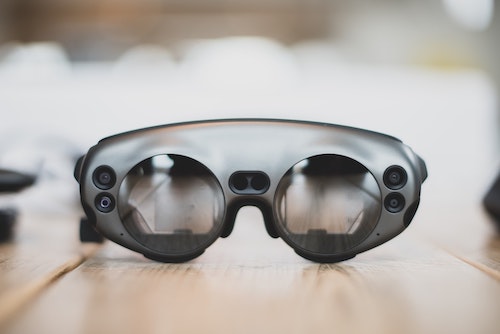Virtual reality, augmented reality, and a mix between the two. These all make up what we know as extended reality, or XR for short. In recent years, interest in extended reality technology has been piqued, as affordability and more creativity paves the way for promising new developments in education and industry.
What used to be mainly implemented in video games (i.e. the virtual reality arcade games of the 90s and beyond) is now being used for other entertainment, as well as business and education. In essence, virtual and augmented reality are providing incredible experiences to extend the learning environment, from K-12 education all the way up to higher learning.
What is Extended Reality (XR)?
Before we get into the finer details of how extended reality can benefit education (along with providing a few examples), first we’ll provide a basic framework of how it all works.
In short, extended reality is an umbrella term to describe alternate reality experiences like virtual and augmented reality. It uses technology to merge the physical world with the virtual world to create an experience that is – literally – unreal. What’s the difference between virtual reality and augmented reality? Let’s say you are looking to purchase a new couch for your living room. Here is how each type of XR would work:
- Virtual reality: You put on a VR headset and enter a virtual experience that replicates your real-life living room. You’re able to see exactly how the new couch would look in your home in a closed-in, 100 percent virtual environment.
- Augmented reality: You use the camera on your phone to see how the couch would fit in your room. Unlike VR, where the entire experience is virtual, augmented reality gives you a digital view strictly on your phone (or another device).
There are profound opportunities for both types of extended reality. In fact, by 2023 the U.S. military will be investing as much as 11 billion in extended reality technologies – the majority of which will likely go to education and training.
 Educational Benefits of Extended Reality
Educational Benefits of Extended Reality
In the educational setting, extended reality allows students to learn in ways they’ve never been able to before. It could be teaching kindergarteners about the solar system, or showing high school students human anatomy, all the way up to preparing medical students to perform life-saving surgical operations.
The ability to mirror real-life situations gives extended reality the benefit of exceeding any possible limit. Obviously, you can’t send a class of first grade students on a field trip to the moon. At least, in the real sense. With a basic VR simulation, they can start exploring the surface of the moon within a matter of seconds.
Through augmented reality tablet applications or full, 360-degree head sets, students can improve their understanding of what life is like all throughout the world. They can stroll through the world’s most famous museums, using applications like YouVisits. They can experience Shakespeare’s Midsummer Night’s Dream in The Globe Theatre. Travel deep into the past to see how the Romans built one of the largest empires in history.
Arguably most important, students are able to gain understanding of real, modern problems that would be difficult to conceptualize otherwise. In effect, XR can encourage empathy in students, as they can build perceptions beyond learning the mundane facts and statistics that are typically prescribed to them. By throwing on a virtual reality headset, they can develop the capacity to feel what other people are feeling (or have felt in the past). They can put themselves into others’ shoes, something that cannot be comprehended by a textbook.
 Examples of XR in Education
Examples of XR in Education
While we’ve already provided a few examples of how extended reality can benefit education, below you will find more specific and comprehensive examples. These are scenarios that could be created through virtual or augmented reality applications. Due to its incredible capabilities, we’ll use a few examples of how virtual reality can be used in education.
First, here is an example we’ve used in a previous article about VR:
Students are plopped into an immersive trip through the inside of a human body. The goal is to bring the body to life by identifying the organs, fixing a few bones, and get the blood flowing.
But there’s a huge obstacle. The heart is in the head, the brain is in the abdomen, and there are bones disjointed and scattered throughout the body. The classmates must work together to put the pieces back together. They have 45 minutes to do it.
Sound better than dissecting a frog? It would be a more memorable experience, arguably a more effective way to educate people on how the human body functions.
Here’s another example, where a class of high school students could enter the Auschwitz concentration camp during World War II:
The class enters the application at the gates of the camp. They see guards, toting rifles. They see crowds of Jewish prisoners from outside the gates. The students then enter the gates of Auschwitz.
They walk around the campgrounds. They tour the dormitories, see the living conditions. And on and on…
You can see, this scenario goes far behind what a textbook can provide. It delivers a visual representation of history that can instill empathy in the student.
Below is our final example. This application could be used for K through 12 and even beyond. The idea would be to show students weather patterns and how our environment changes over time.
It begins in the Arctic Sea, the fastest changing environment in the world. A timelapse reveals changes in the ocean and sea-ice environment – everything from biological processes to geological changes.
With the click of a button, students are transported to the Rocky Mountains, where they are able to see how changes in the Arctic may impact snow pack and other ecosystems.
A critical benefit of adding extended reality to the educational mix is that it captures the attention of the student. If you’re an educator, you know, 15 minutes into a 30-minute lecture and you’ve lost the minds of half your students.
XR encourages engagement. It breathes a fresh breath of life into education.
